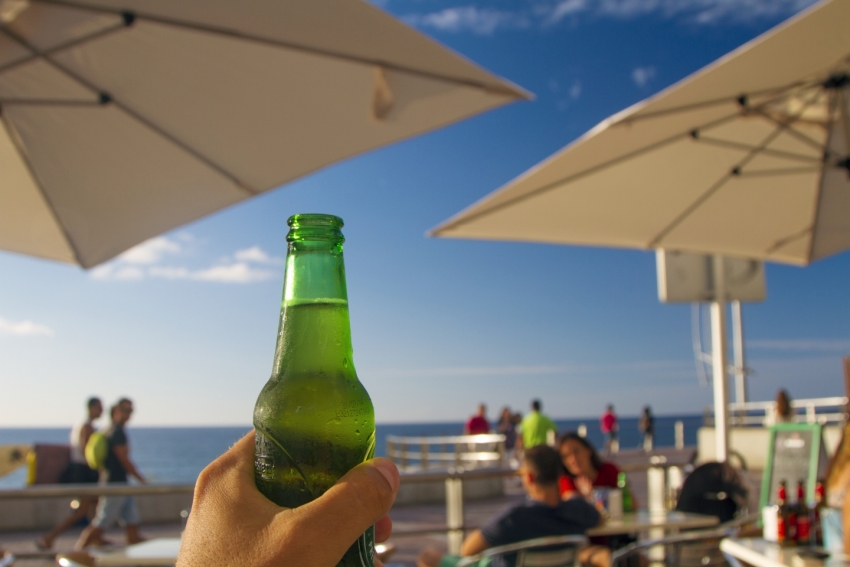Gourmet Canarian Foods You Have To Try In Gran Canaria
Gran Canaria might not seem like a foodie destination when you're tucking into an all-day breakfast in a shopping centre but plenty of delicious local produce out there. Here's a selection of the best Canarian food and drink to try and buy.
Flor de Guia Cheese
Moist and slightly bitter with a faint taste of grass and old socks: Gran Canaria’s Flor de Guía is the island’s most distinctive cheese. It’s made by traditional methods and protected by an EU Designation of Origin. It is also one of the few cheeses that uses natural vegetable rennet (extracted from thistle or cardoon flowers) rather than animal rennet. This makes it suitable for vegetarians.
Creamy flor de Guia cheese has a soft, yellow rind and is creamy and riddled with small holes. It comes in thin wheels about four inches deep.
You can buy Flor de Guia in the shops but it isn’t the real stuff. Most of the vacuum packed supermarket stuff is media flor made with a mixture or animal and vegetable rennet. It tends to be much denser and dryer than pure flor de Guia. For the genuine article head to the cheese stall at one of the island’s markets. Guia town itself has a tiny Sunday market in front of the church but nearby Galdar’s Thursday market is much bigger.
Agaete Coffee
A small bag of Gran Canaria coffee costs over 15 euros because it is only grown in the mild Agaete Valley. Known as Europe’s only coffee but a more accurate description is the most northerly coffee in the world.
Coffee was first grown in Gran Canaria in 1788 but faded away except in Agaete where the farmers grew if for their own morning cuppa. The bushes grow organically in the shade of mango, papaya and orange trees. Gran Canaria coffee beans are hand picked and sun dried and yield a delicate, fruity coffee with a hint of liquorice. Pretty tasty!
We’ve noticed a lot of coffee bushes lining banana plantations in the hills behind Galdar and Arucas so it won’t be long before the supply increases.
Temisas Olive Oil
Olive trees live a long time and don’t bear grudges. That’s just as well considering that Gran Canaria neglected its groves for over 100 years. The goats ate most of them and the small harvest was pickled ferociously in mojo.
The somebody tested the oil from the gnarled old trees and found that it is first class. Now the olivos are Gran Canaria’s latest way of turning the sunshine into gold.
Farmers are busy learning the skills that their grandparents forgot and new groves go in every year. The best Gran Canaria olive oil comes from the old trees around Temisas, the town with longest history of olive growing in the Canary Islands.
Temisas’ grizzled survivors are old varieties that have died out everywhere else in Spain. Their oil is fruity and herbal with a good peppery kick and a distinctive smell of ripe tomatoes.
Gran Canaria’s olives are harvested by hand and cold pressed. A small bottle costs about 5 euros and is best served on salads or used plain as a dip for fresh bread. It’s too good to wreck with balsamic vinegar so use a white wine vinegar instead.
Fresh Tropical Fruit
The best tropical fruit in Gran Canaria never makes the supermarkets. It’s sold in local markets and village shops. Look out for boxes of fruit that smells fantastic and has fresh green leaves still attached.
Because Gran Canaria is so high we also grow fabulous soft fruit like peaches, apricots, plums, apples and pears. Gran Canaria’s oranges are fantastic, especially the huge navel oranges that ripen during the winter.
Gran Canaria’s bananas are fantastic and taste far better than the Caribbean bananas you get in European supermarkets. It’s because they are a sweet variety and are picked ripe and never refrigerated. Bananas are available all year round.
Gran Canaria’s pineapples are delicious and are available most of the year. Only buy them if you can smell them. Papayas are harder to judge but go for the deepest colour orange or red you can find and leave them to soften for a day or two before eating.
Fresh Fish and Seafood
Most of the fresh fish sold in restaurants in Gran Canaria is farmed seabass (lubina) and gilthead bream (dorada). They are delicious and farmed locally but nothing beats fresh fish caught from the open ocean on the same day as it is cooked. Look out for fresh bonito and tuna and try local favourites like grouper (mero), cabrilla (comber), vieja (parrotfish) and medregal (amberjack).
The trick to finding the best fresh fish in Gran Canaria is to head to the little local restaurants right by the sea. The best have the fish displayed in a cabinet or on a dish by the entrance. Look for fish that is shiny with clear, glossy eyes. If the eyes are opaque or sunken you are looking at old or defrosted fish.
Squid freezes well so it doesn’t have to be fresh
Almogrote
La Gomera’s answer to pesto, almogrote is a tasty spread made from cured goat cheese, garlic, chili and olive oil. It’s traditionally served on pan bizcochado (crispy double-baked bread).
Almogrote is delicious but make sure you all eat it together as it’s full of garlic. You can buy glass pots of almogrote in most Gran Canaria supermarkets: Try and find one that is made in La Gomera rather than in Gran Canaria or Tenerife: It’s just fairer.
Guarapo
Guarapo or palm honey is another Canarian delicacy from la Gomera: It’s our equivalent of maple syrup and is fantastic on pancakes.
Guarapo is made from sap extracted by hand from La Gomera’s many palm trees. Each tree can only be tapped once every seven years: Someone climbs up each tree and cuts into the bud. The sap drains out and is boiled down into a thick, dark syrup.
La Gomera’s palm honey harvest is a fantastic and sustainable local industry that guarantees the future of the islands palm trees. Taking a bottle home helps support the Gomeran’s traditional way of life.
Supermarkets sell bottles of guarapo for about seven euros. Don’t confuse it with miel de caña or cane syrup as this is imported and nowhere near as tasty.
La Palma Salt
Sea salt from Fuencaliente in the far south of La Palma comesa from outdoor salt pans and is made by traditional methods. The best is called flor de sal which is light, fluffy scales of salt rather than big grains. It's highly rated by top chefs for its clean taste and purity. Look out for the purple packs of flor de sal flavoured with local red wine: Perfect for seasoning stews and grilled meat.
Wine
Canarian wine is so good that we've given it it's own section. While Lanzarote's whites and Tenerife's red are the easiest to find in the superamrkets it's worth tracking down Gran Canaria's white wines as they get better every year. Click here to visit our wine section.
Gran Canaria Info recommends:
- Default
- Title
- Date
- Random













